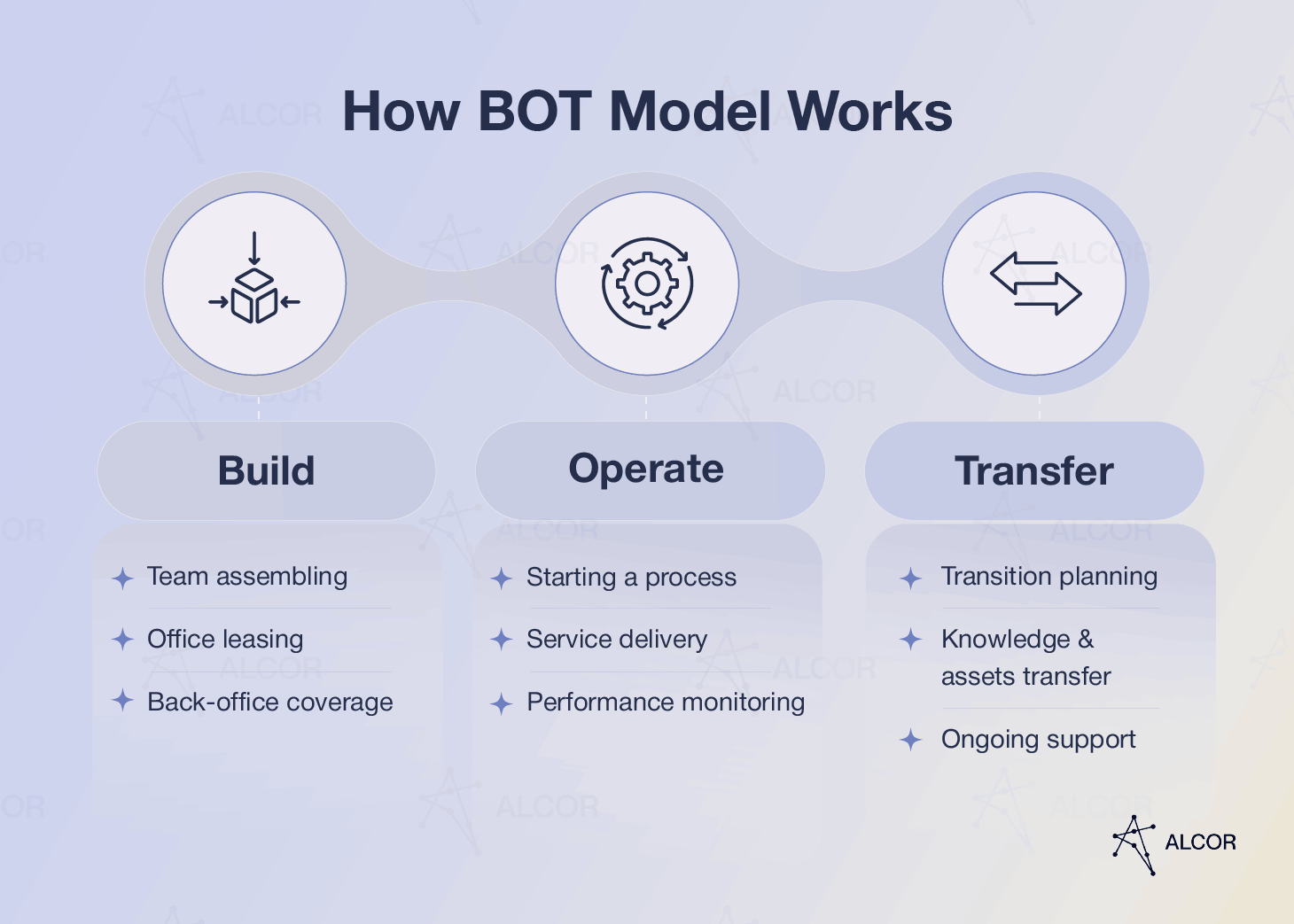In 2025, 50% of global companies are already using BOT or BOTT models for their global in-house centers, with over 70% seriously considering it. The main reason is that Build-Operate-Transfer lets tech businesses quickly and cost-effectively build offshore tech teams with vendor support, then take over once stable – avoiding the pitfalls of traditional IT outsourcing.
I’m Dmytro Ovcharenko, CEO at Alcor, where we simplify the expansion of US tech companies into Latin America and Eastern Europe with our tech R&D center. We scale teams from 10 to 100 Silicon Valley-caliber engineers in a year with full Employer of Record and operational support. Most importantly, it is all for 40% less than IT outsourcing.
So, is the BOT model the right fit for your expanding tech business? In this article, you’ll explore its pros and cons, real use cases, and hidden risks – plus an alternative approach that’s built for today’s product tech companies.
Key Takeaways
- Each stage of the BOT model – Build, Operate, Transfer – delivers a critical function: hiring, managing, and transferring a full tech team under your control.
- Build-Operate-Transfer in IT outsourcing gives CTOs of tech companies access to elite talent in regions like LATAM and EE, where companies can save up to 53% on employment costs by hiring top-tier engineers from leading STEM universities.
- The BOT model isn’t perfect: challenges like offer rejections, vendor interference, transfer delays, and handover fees can derail a project if the wrong partner is chosen.
- BOT is great for testing new markets. But if you need speed, transparency, and full control from day one, ODC, built with Alcor, outperforms both BOT and GCC.
- With Alcor’s software R&D center solution, you get the best of BOT without transfer fees, lock-ins, or operational risks – just your dev team, your way.
What is a Build-Operate-Transfer Model?
The Build-Operate-Transfer (BOT) model is a contractual setup in which a company outsources the construction, operation, and eventual transfer of a project or facility to a specialized partner.
In IT outsourcing, this business model is used to launch an offshore subsidiary with full control, IP rights, and a ready-made development team transferred to the client at the final stage. With 2025’s shift toward in-house tech maturity, companies are rethinking quick-fix outsourcing, as BOT offers a controlled path to build tech muscle, not just borrow it.
How Does a BOT Model Work in IT Outsourcing?
As its name suggests, the BOT model in the IT industry unfolds in three main stages:
1. Build
The first stage of this model spans the creation of a client’s subsidiary in the chosen offshoring location. It presupposes the following steps:
- Team assembling. To get the ball rolling, the service provider performs IT staffing via the Build-Operate-Transfer model to build a development team tailored to the client’s project needs. This may require hiring additional staff, which can sometimes be a time-consuming process.
- Office leasing. Simultaneously, the offshore provider secures office premises that will eventually evolve into the R&D center for product development.
- Legal & admin coverage. To ensure smooth operations, the BOT partner takes care of employment contracts, payments, compliance with local jurisdictions, and HR. Some providers, such as Alcor, go further. They offer Employer of Record services tailored for tech companies, streamlining employment and reducing IP and compliance risks.
2. Operate
Then, the BOT partner assumes the day-to-day operations, team management, and project supervision. This phase includes:
- Starting a process. With the team in place and the infrastructure ready, the third-party vendor initiates the development process. This involves effective team management, organizing workflows, and progress tracking.
- Service delivery. The focus during this stage is on delivering top-notch services to the company. The BOT partner adheres to service level agreements, maintains operational efficiency, and continually enhances service delivery based on feedback and industry trends.
- Performance monitoring. The BOT partner diligently monitors project progress by keeping an eye on key performance indicators (KPIs) and implementing metrics to assess team output and technical capabilities. They provide regular reports that highlight areas for improvement and propose optimization strategies. This stage ensures a proactive approach to project management and continuous performance enhancement.
3. Transfer
The final act of the BOT model for the IT industry is the smooth handover of operations, team, and assets to the client. Let’s break it down:
- Transition planning. In this crucial phase, the BOT service provider creates a step-by-step roadmap to transfer the subsidiary, including operations, documentation, and responsibilities, to ensure minimal disruption.
- Knowledge & assets transfer. The partner company ensures the client’s team is well-prepared to take over the ongoing product development. It’s about handing over the keys to the kingdom – physical assets, intellectual property, and operational contracts. This process involves legal and financial assistance to ensure compliance with relevant regulations.
- Ongoing support. Even after the transfer is in the bag, the BOT partner stays in the wings, offering support during the initial transition. They remain accessible for consultations and troubleshooting, ensuring a smooth and supported transfer of ownership. This ongoing support underscores the commitment to the client’s success beyond the formal handover.
Sounds a bit overwhelming? Here is a simpler, low-risk solution – a software R&D center. It works like a Build-to-Operate model, but without vendor lock-in, talent dedication, or transfer issues. You get a loyal team under your brand from day one, protected IP, and full transparency, minus the usual disadvantages of IT outsourcing.
5 Benefits of the Build-Operate-Transfer Model for IT
To understand exactly what you’ll receive from BOT, I’ll cover both the advantages and disadvantages of this model. Firstly, let’s look at its key benefits:
1. Access to the large talent pool
If you’re based in the United States and have faced the challenge of talent shortage, then you’re probably in the 60% of tech companies that struggle to find skilled developers. This is a huge stumbling block to effective team expansion for SMBs and enterprises alike.
The Build-Operate-Transfer in software development opens the door to a huge tech talent pool in offshore and nearshore locations. For example:
|
Eastern Europe |
Latin America |
|
|
Tech talent pool |
1.8M |
2M |
|
Main tech skills |
Java, Python, C++, TypeScript, PHP, HTML |
Java, Python, Ruby, C++, C#, React, SQL |
|
Tech hubs |
Poland, Romania, Ukraine, Bulgaria |
Mexico, Colombia, Argentina, Chile |
Most of these software engineers and programmers are college graduates from the leading STEM universities with exceptional technical expertise and high English proficiency, who will gladly apply their knowledge to your product.
2. No white labeling
Compared to an outsourced team, a build-operate-transfer in Europe or LATAM agreement team is your employees who work under your brand from the beginning. They will not develop a product and then just let you rebrand it. Developers hired through a BOT provider are essentially an extension of your in-house team – they’re the peas in your pod, dedicated to your product’s success. The only distinction is their geographical location; otherwise, they’re in the same boat, which boldly rows towards triumph.
3. Substantial cost savings
Creating your development team through the Build-Operate-Transfer in LATAM or Eastern Europe is a viable way to reduce developer compensation costs. For instance, the average senior developer salary in Mexico ranges from $58,000 to $82,000 a year. In Romania, experts of the same level earn from $61,000 to $84,000 annually. But this number breaks all records in the USA, from $109,000 to $140,000 per year. This allows US tech companies to save up to 60% on programmers’ salaries.
Take a look at the table below to compare yearly senior developer rates by region.
|
Senior position, USD, Gross |
USA |
Eastern Europe |
LATAM |
|
AI/ML Engineer |
151,800 |
75,900 |
73,875 |
|
Cloud Engineer |
146,400 |
76,050 |
65,400 |
|
Mobile Developer |
165,000 |
75,900 |
67,350 |
|
Automation QA Java/JS Engineer |
123,000 |
63,300 |
57,300 |
|
C/C++ Developer |
114,000 |
72,000 |
61,050 |
|
Blockchain Developer |
156,600 |
71,250 |
72,450 |
|
React.JS Developer |
120,000 |
70,500 |
54,300 |
|
Python Developer |
132,000 |
73,950 |
66,600 |
|
PHP Developer |
102,000 |
63,000 |
58,200 |
|
Java Developer |
110,400 |
75,900 |
60,900 |
Plus, when you hire developers via a B2B contract, common in both LATAM and Eastern Europe, you, as a client company, are free from tax obligations, while your contractors handle taxes and social contributions themselves. This setup makes IT staffing via Build-Operate-Transfer even more cost-efficient – no payroll taxes, fewer liabilities, and clean paperwork.
4. Operational back-up
When you partner with an IT vendor in the offshoring country, they become your one-stop shop for all administrative tasks. It’s like having a reliable co-pilot – they handle everything from hiring software developers and managing payroll to negotiating office leases and offering tax consulting.
But that’s not all – legal matters are covered too. Lawyers well-versed in international IT law ensure your offshore branch complies with all regulations. They go the extra mile by preparing the necessary documents for a seamless R&D transfer. This comprehensive support means you can kick back a bit – stay focused on your product while your vendor takes care of the operational heavy lifting.
5. Control over the processes
Another advantage of the Build Operate & Transfer solution is staying closely involved in the development process – a level of engagement often unachievable with traditional outsourcing practices. Agreeing with your BOT partner on the operational structure and development processes will give you peace of mind about proper task fulfillment. Once the transfer phase is over, you will get a team that is perfectly aligned with your business strategy.
5 Challenges of Using the BOT Model for IT Outsourcing
Even though you can reap certain benefits of BOT, here are the five difficulties that you need to ponder:
1. Offer rejections from candidates
When expanding to a new offshoring destination, your company may struggle to attract talent, especially if local candidates are unfamiliar with your brand. Why? Because if candidates don’t know a thing about your business, they’re unlikely to add such working experience to their resume.
The only effective way to address this issue is through powerful employer branding. A successful Build-Operate-Transfer model in the IT industry involves partnering with a vendor that incorporates employer branding into your offshoring strategy. That means a vendor established a local presence for you: promoting your unique EVP, launching successful PR and SMM campaigns, and integrating your corporate culture.
A real-life example is the case of the US tech company Sift. Their goal was ambitious: to hire 5-10 developers in just 3 months and scale fast, but lacked local visibility. So, they turned to Alcor, one of the few companies that runs employer branding for tech. We launched a video with Sift’s Hiring Manager on social media and boosted their offer acceptance rate by 15%! The result? A fully backed R&D center of 50+ people in EE, controlled and managed by our client from day one.
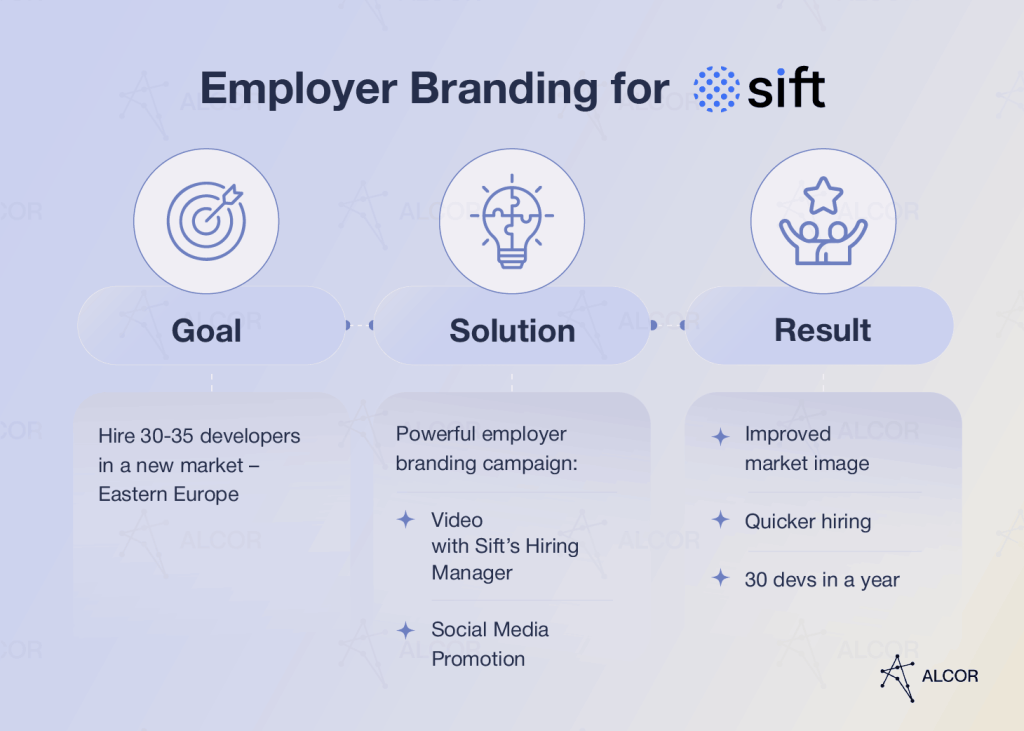
2. Developer dedication issues
In Build-Operate-Transfer (BOT), ownership matters from the get-go. If the structure isn’t yours right from the start, developers may feel torn between your product and the vendor’s legacy. Some BOT providers don’t recruit software engineers directly to your company but assume the role of an employer. Sometimes, they even try to interfere with product development and team management. So, developers might be confused about whom to report to. Ideally, decision-making should stay in-house, and your core code and sensitive data should remain under your control.
3. Team transfer complexities
The transfer phase in a BOT model in software development can be lengthy and complex. Initial challenges arise during the skills and knowledge transfer phase, where effective communication is crucial for the client’s team. There is also a risk of losing some personnel or facing temporary drops in productivity due to the changes introduced during the transfer.
Additionally, the transfer process can be complex from a legal perspective. These include compliance with local laws and regulations, data protection and privacy regulations, licensing of intellectual property, signing non-compete and non-disclosure agreements, etc. It’s essential to conduct thorough due diligence before and during the branch transfer process.
4. High initial costs & transfer payments
The Build-Operate-Transfer model in software engineering typically starts with substantial upfront costs: office lease, infrastructure development, hardware, and legal setup.
What’s less obvious are transfer payments or handover fees – vendor-claimed charges per engineer at the transfer phase. These can turn a cost‑efficient setup into an expensive surprise, especially for smaller companies.
5. Poor operational management
A common misconception is that only providers offering professional IT services can effectively execute the Build-Operate-Transfer in the software development model. However, these firms may lack the expertise in building and running R&D offices, which involves substantial administrative support. To ensure your investment in offshoring is effective and well-spent, selecting a vendor with practical experience in establishing R&D offices tailored to companies like yours is crucial. Discover how to make the right vendor choice by continuing to read this article.

3 Opportunities When Using the BOT Model
1. Global expansion
Expanding engineering teams across borders is one of the fastest ways to overcome local talent shortages and scale product delivery. In this regard, the build-operate-transfer model for tech companies can become the magic pill, allowing them to enter new markets and tap into their vast potential.
2. Technology adoption
Staying abreast of innovations is paramount, but access and resources can be limiting. Collaborating with an offshore BOT partner is a game-changer, as these service providers are often at the forefront of industry trends. This cooperation empowers tech companies to embrace cutting-edge technologies and best practices without hefty investments.
3. Focus on retention
The BOT model liberates tech companies from secondary tasks. Instead, it allows them to focus on top-priority activities and long-term business objectives. With more resources from the BOT partnership, IT companies can accelerate their time-to-market, ensuring a sharper competitive edge.
3 Threats of Build-Operate-Transfer
1. Contractual risks
Working with service providers introduces the risk of encountering contractual pitfalls, such as financial issues, IP ownership, KPIs, confidentiality terms, force majeure, and termination aspects. Navigating these legal and contractual intricacies during BOT agreement negotiation and project execution is crucial to prevent disputes and delays.
2. Dependency on a service provider
Heavy reliance on the service provider for critical project aspects, including development, operation, and maintenance, poses a significant risk. If the relationship deteriorates or the transfer stage is mishandled, this dependency can become a threat to the project’s success.
3. Long-term financial commitment
Engaging in a BOT model involves a long-term financial commitment, particularly during the operating phase. IT companies may encounter challenges if unexpected financial pressures emerge or if the cost structure becomes unsustainable. Despite aiming for cost predictability, there’s a risk of cost overruns, especially in the face of unforeseen project challenges.
BOT model vs. GCC vs. ODC
Choosing the right engagement model is key to building a scalable tech team abroad. BOT, GCC, ODC – which one is the most optimal for expanding abroad? Let’s look at them in detail.
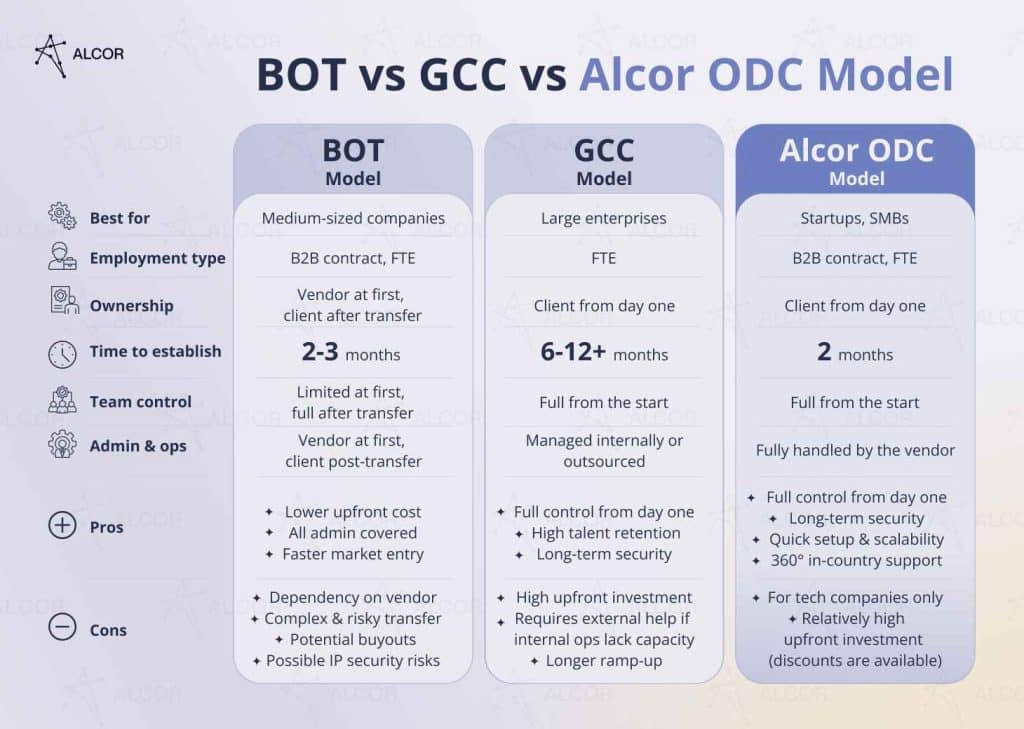
The Build-Operate-Transfer model and the Global Capability Center as a service (GCC) both result in a client-owned offshore team, but their approaches differ. While GCCs are owned and operated by the client from day one, BOTs start with vendor control and end with a handover. BOT is faster and less resource-intensive, making it more suitable for tech companies testing new markets. GCCs, on the other hand, are a better fit for large enterprises with long-term expansion strategies and in-house operational capacity.
Unlike BOT or GCC, an Offshore Development Center (ODC) gives tech companies immediate control without the wait or vendor lock-in. Alcor’s ODC model goes even further. It combines the speed and flexibility of BOT with the long-term security of a GCC – all without transfer fees, buyouts, or IP issues. You get your own team, your processes, and 360° in-country support from day one.
Build-Operate-Transfer Examples in the IT Industry
The BOT model in software development has helped many tech companies launch and scale offshore teams with impressive results.
One mid-sized fintech firm, for example, used it to build a 40-person engineering team in Eastern Europe, gaining access to senior tech talent and reducing payroll costs by over 50%. With a structured setup and a clear agreement, they transitioned the team into their internal structure smoothly, proving the value of build-operate-transfer in IT outsourcing for tech companies that need to scale efficiently and retain control.
But BOT doesn’t always go according to plan. Some tech companies face turbulence during the transfer phase – from unclear ownership of infrastructure and IP rights, to fragmented workflows across vendors. Others discover hidden fees or rigid contract terms buried deep in their original agreement. In some cases, the handover of the subsidiary gets delayed or messy, leading to team churn or lost momentum at a critical growth stage.
That’s why many tech executives now lean toward models that offer more control from day one. For instance, People.ai, BigCommerce, ThredUP, and Dotmatics have already tested a turnkey software R&D center solution:
- Silicon Valley-caliber engineers – we recruit top senior talent with strong product thinking in just 2-6 weeks.
- Cut your costs by 40% – build elite teams in LATAM or EE without smashing your hiring budget against the outsourcing wall.
- No buyout. No setup. No surprises – you pay only for results with fully transparent pricing.
- Your team, your rules – full IP rights, your brand, and no vendor control from day one
It’s like running BOT in reverse: full control first, no transfer drama later.
Variations of the BOT Model for the IT Industry
Build-own-operate (BOO)
The BOO model is used across industries, including IT. This model is a form of public-private partnership in which the private sector finances, builds, owns, and operates an infrastructure facility. What sets the BOO model apart is that the entity maintains ownership of the project not only during construction but also throughout the operational phase. This fundamental distinction separates it from the Build-Operate-Transfer (BOT) model.
Build-own-operate-transfer (BOOT)
The BOOT model is popular in public-private partnerships and is also applied in tech when building and managing IT infrastructure. It finds frequent application in scenarios where private sector involvement is sought to fund and develop public infrastructure. Unlike the BOT model, the service provider in the BOOT model retains ownership during the operational phase, which can lead to legal and technical complexities during the final transfer.
Build-lease-transfer (BLT)
The BLT model is a project delivery and financing model akin to the Build-Operate-Transfer concept. In the BLT model, the primary stages entail constructing and leasing a project to the client for a designated period. The transfer stage may or may not take place, contingent on the terms of the agreement. Another difference from the BOT model lies in operational responsibilities, typically shifted to the client during the leasing stage.
Build-Operate-Transform-Transfer
The BOTT model is a variation of the traditional BOT, which presupposes an additional stage of transformation. Before transferring ownership, the BOTT service provider modernizes or optimizes the system to meet evolving needs or tech standards. While offering advantages in terms of improved outcomes, the BOTT model typically demands additional time and financial resources due to the extra stage.
When IT Business Should Use Build-Operate-Transfer Model
1. When there’s a lack of specialized tech skills.
If your local market lacks the tech expertise you need, the BOT model for the IT industry is your way to go. It enables businesses to tap into a broader talent pool in offshore or nearshore locations, such as LATAM and Eastern Europe. This is especially useful when a project requires specific skill sets.
2. When in-house software development becomes expensive.
As we know, software development is not as cheap as chips, and scaling an internal dev team in the US can quickly drain your budget. The annual employment cost for a single senior developer hits around $174,000/year, including salary, benefits, and a recruitment fee. Compare that to $89,150 in Eastern Europe or $82,100 in LATAM – a savings of nearly 49–53%.
This is where the Build-Operate-Transfer for tech companies comes in handy, enabling cost-effective expansion. A key to making it work? Choosing the right partner who can guide you through the Build-Operate-Transfer model in LATAM or Europe. They will help you pick the best-fit region based on tech talent, costs, cultural and time zone proximity.
Thinking about expanding to Eastern Europe? Discover the benefits of software development in Poland!
3. When it’s time to scale up a business.
The build-operate-transfer for tech companies serves as a well-structured pathway for those eyeing expansion to a new geographic location. It streamlines the process of establishing a remote tech team while offering crucial operational and administrative support. This not only establishes a solid foundation for confidently entering a new market but also opens up opportunities for substantial business growth.
What to Consider When Looking for a BOT Model Partner
Choosing the right Build-Operate-Transfer (BOT) partner is a crucial decision that can significantly impact the success of your project. Here are several key considerations to keep in mind when looking for a BOT partner:
BOT experience
When entering a BOT partnership, prioritize service providers with specific knowledge and experience in the BOT model. It’s crucial to scrutinize their track record, delve into success stories, and explore reviews on independent platforms. An experienced vendor should showcase a well-defined BOT strategy encompassing every aspect of your partnership. This ensures a smoother and more successful collaboration.
IT staffing expertise
As I mentioned above, software team building is essential to the BOT model. Your trusted partner should be able to hire perfectly matching software developers for your crew. The IT staffing via the Build-Operate-Transfer model involves a meticulous assessment of candidates, considering both their hard and soft skills. Additionally, evaluating English proficiency and cultural fit ensures a cohesive and effective team for seamless cooperation.
Operational management
Another aspect to consider is the vendor’s experience with setting up processes and consistently delivering timely, high-quality results. This encompasses the efficient management of back-office functions such as payroll, legal matters, and equipment procurements, along with the establishment of a productive workflow. Your ideal partner should be goal-oriented, proactive, and resourceful. Their forward-thinking approach will not only drive success but also help mitigate potential risks and challenges.
Legal competence
A reliable partner guarantees a smooth transition when the project returns to your company. This hinges on the vendor’s ability to navigate the local market from legal and compliance perspectives. They should not only know how to register your subsidiary and employ programmers but also be well-versed in the nitty-gritty details of transferring this unit during the final stages of the partnership.
Why Settle for BOT only? Launch Your Own Software R&D Center!
While the Build-Operate-Transfer in software engineering presents risks, especially during the transfer stage, there’s a better solution on the horizon. Setting up your own R&D center abroad proves to be a win-win choice.
Alcor is here to make it happen for you, whether in Latin America or Eastern Europe. Our specialization lies in assisting the US and Western European tech companies in:
- Hiring & all ops covered – build and scale high-performing R&D teams in just one month
- Launching without a legal entity – we handle employment, compliance, and payroll through our EOR for tech
- Building to retain – our engineers stay long-term, with 98.6% passing probation and 2.5 years average tenure
A testament to our success is the R&D office with 25+ rare programmers that we established for People.ai. They not only attracted a significant $100 million in investments but have now soared to an impressive valuation of over $1 billion!
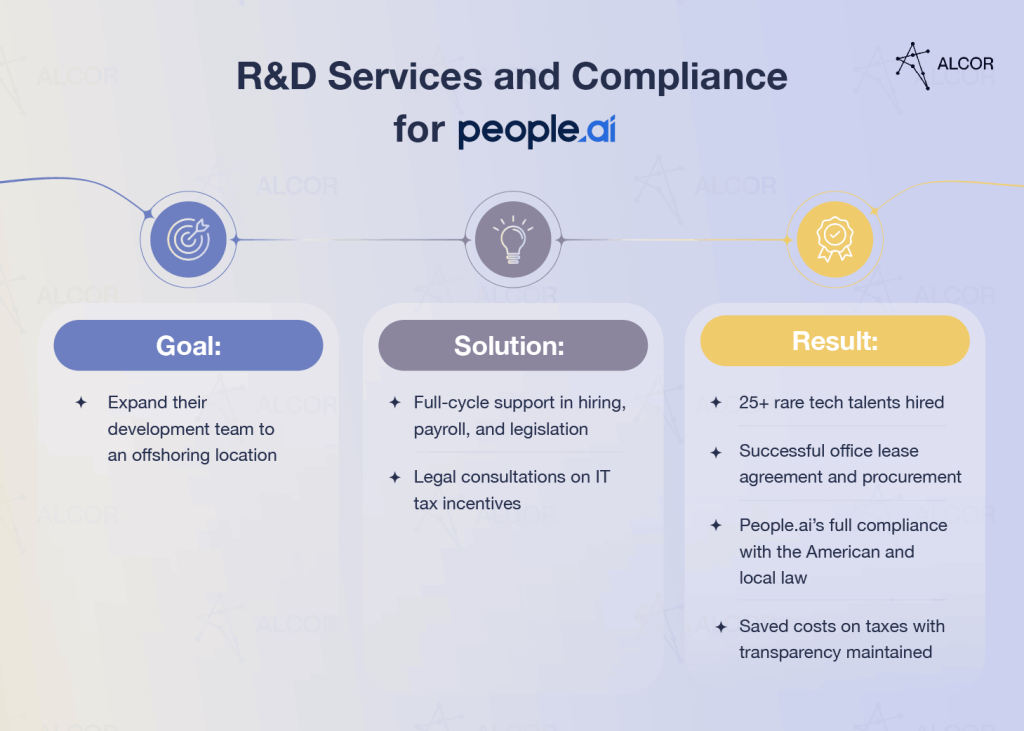
How do we work?
To ensure your successful expansion to a nearshoring or offshoring destination, we follow a structured approach:
- Get top tech talent fast – our tech recruitment team delivers senior engineers that match your stack and culture.
- Hire engineers compliantly via EOR – we handle payroll, legal, and compliance without needing a legal entity.
- Set up your own software R&D center – with full operational support: office lease, IT infrastructure, and back-office setup.
We also assign an account manager to oversee and address any operational issues that may arise during the expansion process.
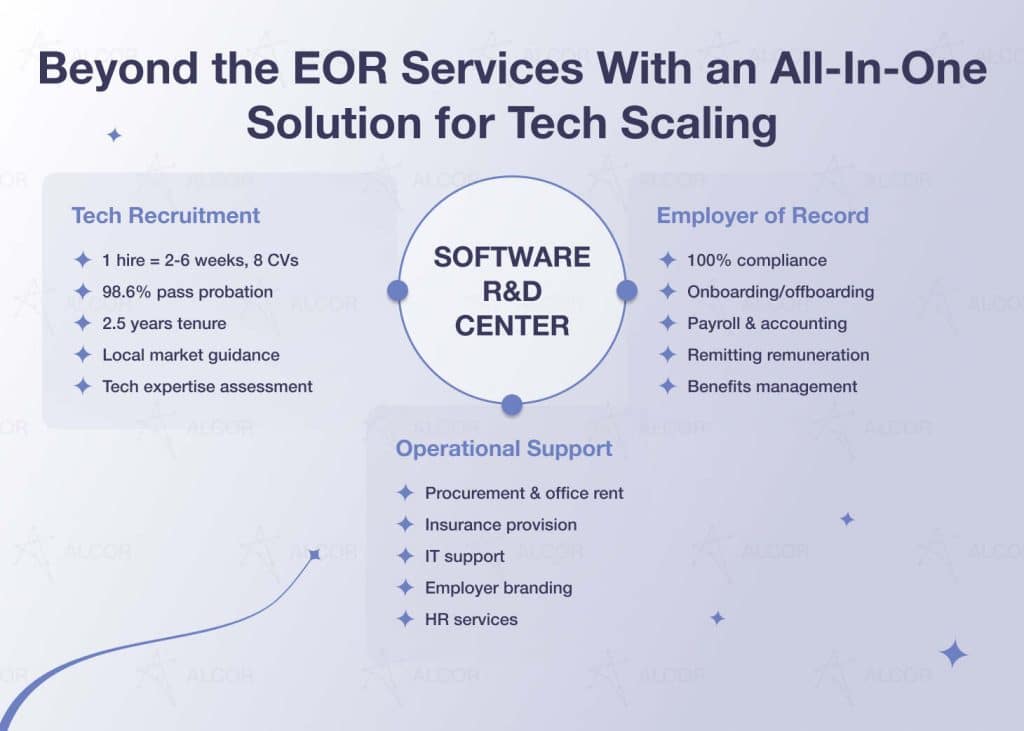
Although our services may seem like a traditional BOT model for the IT industry, we don’t have the “transfer” stage that implies buyout fees and additional transfer costs. Since the development team belongs to you from the very beginning, we don’t take over direct management of your team or software development; instead, we legally protect your IP rights to ensure confidentiality.
Want to learn more about our turnkey R&D center solution? Fill the form below and let’s chat!
FAQ
1. What’s the difference between Build-Operate-Transfer and Managed Services?
Managed services cover specific tasks like infrastructure or tech support, while Build-Operate-Transfer handles the full setup of your offshore dev team with a final handover. BOT offers clearer guarantees – including transparent pricing, hiring KPIs, and legal compliance. It’s a better fit for tech companies that want full control and long-term ownership of their teams.
2. How to measure the efficiency of your BOT performance?
Track key metrics across each BOT stage: time-to-hire and offer acceptance rate during Build, delivery speed and SLA adherence in Operate, and knowledge transfer success during Transfer. Also monitor retention, cost savings, and how well your team aligns with business goals – all signs of a well-executed BOT model.
3. How should a tech business choose a Build-Operate-Transfer location strategy?
Start by evaluating your priorities, including talent availability, cost efficiency, time zone alignment, and legal environment. Regions like LATAM and Eastern Europe offer strong engineering talent and up to 53% lower employment costs. A reliable BOT partner will help you assess country-specific risks, salary benchmarks, and scalability potential to find the best fit.

